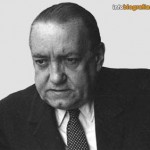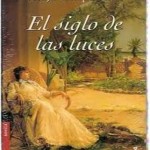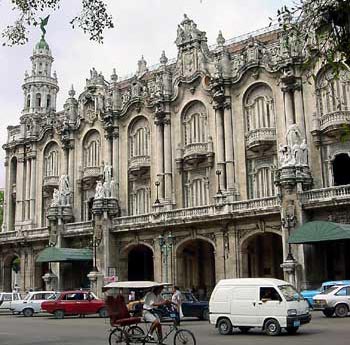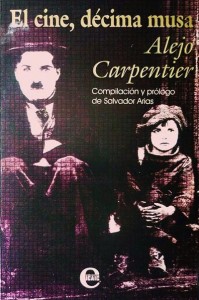Alejo Carpentier, Writer, was born December 26, 1904, in Lausanne, Switzerland -died April 24, 1980, Paris, France. Though born in France he claimed he was Cuban-born. He was taken to Havana as an infant.
The language that he spoke first was his father’s, however, which left him with a French accent in Spanish. In Havana he acquired a superb education in private schools, his father’s library, and the University of Havana. Carpentier was among the founders of the Afro-Cuban movement that sought to incorporate African forms into avant-garde art, particularly music, dance, and the theatre.
In the 1920s he cofounded the Afro-Cuban movement to incorporate African forms into avant-garde art. He was a leading Latin American literary figure, considered one of the best novelists of the 20th century. He was also a musicologist, an essayist, and a playwright. Among the first practitioners of the style known as “magic realism,” he exerted a decisive influence on the works of younger Latin American writers such as Gabriel García Márquez. Carpentier wrote several opera librettos and ballet pieces with Afro-Cuban themes, and in 1933 he published a novel Ecue-Yamba-O! (“Praised Be God!”), in the same vein. In 1928 Carpentier had fled Cuban dictator Gerardo Machado’s repressive regime and settled in Paris. He remained in France until 1939, when he returned to Havana. In 1945 he left Havana again, this time for Caracas, Venezuela. The next year he published La musica en Cuba (“The Music of Cuba”), based on extensive archival research.
Using that documentation, he began to publish short stories with historical background and instances of the fantastic. This combination became the hallmark of his work and the formula for “magic realism.” “Viaje a la semilla” (1944; “Journey Back to the Source”), for instance, set in 19th-century Cuba, is told in reverse, from the protagonist’s death to his return to the womb. This and other stories would be collected in the important volume Guerra del tiempo (1958; War of Time). Carpentier’s second novel, and the first to enjoy wide acclaim, was El reino de este mundo (1950; The Kingdom of This World); it is about the Haitian revolution. In the prologue to this work, Carpentier expounds on “magic realism,” which he defines as the representation of “marvelous American reality.” His novel Los pasos perdidos (1953; The Lost Steps), his best-known work, is the first-person account of a character who travels to the Orinoco jungle in search of the meaning of life and the origins of time.
In 1959 Carpentier returned to Havana to join the victorious Cuban revolution. He would remain faithful to Castro’s regime, serving as a Cuban diplomat in Paris from the middle 1960s until his death. In 1962 Carpentier published another historical novel, El siglo de las luces (Explosion in a Cathedral), which chronicles the impact of the French Revolution on Caribbean countries. It was very successful and there were calls to award Carpentier a Nobel Prize, something that eluded him.
In his final years Carpentier turned to lighter, sometimes humorous fiction, as in Concierto barroco (1974; Eng. trans. Concierto barroco), El recurso del método (1974; Reasons of State), and El arpa y la sombra (1979; The Harp and the Shadow). In the latter, the protagonist is Christopher Columbus, involved in a love affair with the Catholic Queen Isabel of Castile. Carpentier’s last novel, La consagración de la primavera (1979; “The Consecration of Spring”), deals with the Cuban revolution.
Source: Wiki/Britannica/Gonzalez/InternetPhotos/TheCubanHistory.com
Alejo Carpentier, Writer
The Cuban History, Arnoldo Varona,Editor
ALEJO CARPENTIER, ESCRITOR
Alejo Carpentier, escritor, nació 26 de diciembre 1904, en Lausana, Suiza, murió 24 de abril 1980, París, Francia. Aunque nació en Francia, según él, era de origen cubano. Fue trasladado a La Habana cuando era un bebé.
En la década de 1920 fue cofundador del movimiento afro-cubano de incorporar las formas africanas en el arte de vanguardia. Él era una figura destacada figura literaria de América Latina, considerado uno de los mejores novelistas del siglo 20. También fue un musicólogo, ensayista, y dramaturgo. Entre los primeros practicantes del estilo conocido como “realismo mágico”, que ejerció una influencia decisiva en las obras de jóvenes escritores latinoamericanos como Gabriel García Márquez.
La lengua que habló primero fue su padre, sin embargo, que lo dejó con un acento francés en español. En La Habana adquirió una educación privilegiada en escuelas privadas, la biblioteca de su padre, y la Universidad de La Habana. Carpentier fue uno de los fundadores del movimiento afro-cubano que trató de incorporar las formas africanas en el arte de vanguardia, especialmente la música, la danza y el teatro. Carpentier escribió varios libretos de ópera y piezas de ballet con temas afro-cubanos, y en 1933 publicó una novela, Ecué-Yamba-O! (“Alabado sea Dios!”), En el mismo sentido. En 1928, Carpentier había huido régimen represivo del dictador cubano Gerardo Machado y se instaló en París. Permaneció en Francia hasta 1939, cuando regresó a La Habana. En 1945 salió de La Habana, esta vez para Caracas, Venezuela. Al año siguiente publicó La música en Cuba (“La Música de Cuba”), basado en una amplia investigación en los archivos.
Con esa documentación, comenzó a publicar cuentos con trasfondo histórico y las instancias de lo fantástico. Esta combinación se convirtió en el sello distintivo de su obra y la fórmula de “Viaje a la semilla” (1944, “Viaje a la semilla”) “realismo mágico”., Por ejemplo, establecer el 19 de la Cuba del siglo, se le dice a la inversa, de la muerte del protagonista a su regreso a la matriz. Esta y otras historias se recogen en el importante volumen de Guerra del Tiempo (1958; Guerra del tiempo). La segunda novela de Carpentier, y el primero en disfrutar de una amplia aclamación, fue El Reino de Este Mundo (1950, El reino de este mundo), se trata de la revolución haitiana. En el prólogo a esta obra, Carpentier expone en el “realismo mágico”, que él define como la representación de su novela Los pasos perdidos (1953, Los pasos perdidos) “real maravilloso americano.”, Su obra más conocida, es la primera persona, sobre un personaje que viaja a la selva del Orinoco en busca del sentido de la vida y los orígenes del tiempo.
En 1959, Carpentier regresó a La Habana para unirse a la revolución cubana victoriosa. Se mantendrá fiel al régimen de Castro, que actúa como un diplomático cubano en París desde mediados de los 1960 hasta su muerte.
En 1962 Carpentier publica otra novela histórica, El siglo de las luces (siglo de las luces), que relata el impacto de la Revolución Francesa en los países del Caribe. Fue un gran éxito y se hicieron llamamientos a Carpentier otorgará un Premio Nobel, algo que se le escapaba.
En sus últimos años volvió a Carpentier más ligero, la ficción a veces humorístico, como en el Concierto barroco (1974;.. Ing. trans Concierto barroco), El recurso del método (1974, Razón de Estado), y El arpa y la sombra (1979, La arpa y la sombra). En este último caso, el protagonista es Cristóbal Colón, involucrado en una relación amorosa con la reina Isabel la Católica de Castilla. La última novela de Carpentier, La consagración de la primavera (1979, “La Consagración de la Primavera”), se ocupa de la revolución cubana.
Source: Wiki/Britannica/Gonzalez/InternetPhotos/TheCubanHistory.com
Alejo Carpentier, Writer
The Cuban History, Arnoldo Varona,Editor







